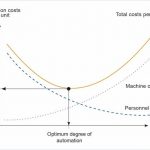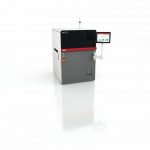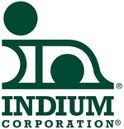High numbers of both existing and potential customers currently want to learn more about the details of the Open Automation principle in ASM’s Centers of Competence. The open and modular approach combines seamless M2M communication with the integration of third-party solutions and existing systems. As a tool for the economically-feasible optimization of processes and for achieving gains in quality and efficiency, Open Automation gives electronics manufacturers the flexibility they need.
A good while ago, a team of experts around Alexander Hagenfeldt, Head of SMT Solutions Marketing at ASM, began to evaluate what opportunities for automation exist along the SMT line and how feasible it would be to implement them under ROI-related aspects. Covering processes ranging from storage and material management, PCB loading, stencil printing and placement to the unloading of finished products, they analyzed each step in great detail – machine by machine, process step by process step.
LEAF model checks four factors
The LEAF model refers to a valuation model developed especially for the economic analysis of process automation. It is based on four factors, clarified below, and serves as a helpful decision-making aid.
Labor, the first factor, looks at how intensive a task is in terms of human labor. Aspects such as time, complexity, required skills needed to complete a particular task are taken into considered and this factor is given a score ranging from one to five.
Error, the second factor, looks at safety risks. How often can an error be made? How severe are its consequences? And how easily can it be detected? The answers to these questions also ultimately result in a score.
Automation, the third factor, looks at the investment needed to automate a machine or process. Investments include not just monetary means but also things like space that needs to be created or a change in the IT infrastructure.
Last but not least, frequency, the fourth factor, looks at how often an event occurs. Examples of these events include machine starts and stops, program changes and solder paste refills. These are all things that can affect the priority level of automating a machine or a process. A task that is easy to perform and not prone to errors but needs to be done regularly may be given priority for planned automation compared to a task that is difficult and error-prone but happens very infrequently.
To determine the most economically sensible automation of an SMT line using the LEAF method, calculations were carried out based on two different production plans. The first was a high-volume, medium-mix profile with high throughput but few setup and job changes. The second was a medium-volume, high-mix profile with up to 12 program changes per day and lower throughput.
Pareto Principle as
economical yardstick
“Together with the experts from ASM, we will use the LEAF analysis to explore the possibilities of automation on our SMT line before defining an individual schedule and priorities,” an electronics manufacturer said during his stay at ASM’s Center of Competence in Munich. “The calculation model makes perfect sense, as does the Pareto Principle used by ASM. Both allowed us to gain valuable insights into automation, particularly with regard to our upcoming investment in a new solder paste printer.”
“Automation is not an end in itself,” says Alexander Hagenfeldt. “The result of any transformation should be a production facility that’s more cost-effective, efficient and flexible while turning out higher-quality products. Looking at the degree of automation under the maxim of achieving the best possible return on investment, the Pareto Principle states that 20 percent of the resources deployed deliver 80 percent of the results. Each additional percentage point of improvement requires a disproportionate amount of additional expenditures.”
Many electronics manufacturers believe that operator-less factories represent the optimum outcome in terms of both costs and efficiency for their production. Nothing could be further from the truth. To assess cost-effectiveness based on a product’s unit costs, we total up its personnel and machine costs. We know that personnel costs decrease as automation increases, but machine costs increase in turn. At a certain point, the machine cost curve increases more than the labor cost curve decreases. This results in rising unit costs caused by excessive automation. The bottom line is that, in most cases, partial automation delivers the best results.
Open Automation printer
For the reasons laid out above, ASM has designed its new DEK TQ solder paste printer with various options that allow the user to automate it in stages under ROI aspects.
- Paste Management
To minimize manual assists during the printing process, the DEK TQ optionally features an efficient paste management system with an automatic paste dispenser and integrated paste height control with individually configurable warning and stop thresholds.
- Dual Access Cover
The DEK TQ’s optional Dual Access Cover makes it possible to switch out paste cartridges without having to stop the printer’s operation. A laterally sliding portion of the cover on the left side of the printer provides full access to the dispensing unit. Since the rest of the cover remains closed, the printer can keep running. ROI calculations show that the fully-automatic Paste Management module paired with the Dual Access Cover pays for itself in only a few months compared to manual operation.
- Eight and more hours of uninterrupted operation
With its highly efficient understencil cleaning system featuring an extra-large 22-meter fabric roll (enough for a whole shift under normal cleaning cycles) and a cleaning fluid tank that holds seven liters, the DEK TQ operates for at least eight hours with no operator assists depending on the cleaning requirements.
- Automated flexibility at the highest level
DEK All Purpose Clamping (APC) is a universal and extremely flexible clamping system from ASM. It can clamp from above, laterally, or in foil-less mode – just as the application requires. DEK APC adapts automatically and reliably to the shape and thickness of the printed circuit board. The clamping is configured in software for each job, and sensors monitor the programmed clamping force. Settings made as part of the product setup can be saved for
future jobs. This results in significant time savings, more paste printing possibilities, and more printing process stability.
- Smart Pin Placement
The optional Smart Pin Placement gives electronics manufacturers another opportunity to reduce manual assists. Two pin sizes (diameters of 4 mm and 12 mm) can be positioned automatically. After placing them, the printer automatically verifies their position and height, with the latter feature being unique in the industry.
With the planned Auto Stencil Exchange module, the stencil is automatically ejected through a slot during a job change. The operator simply grabs the old stencil and inserts the new one. The advantage is that the machine cover does not need to be opened. Compared to a fully-automatic solution where a robot performs the entire changeover, a human operator performs much faster with this solution.
More on Open Automation
The new DEK TQ printer is just one example of the impact that Open Automation can have on electronics production. To provide a closer look at Open Automation, in March 2022, ASM began a monthly livestream featuring hook-ups to international SMT hot-spots, interviews with experts, application models, and more. These livestream sessions aim to help answer questions like: Why automate? How can individual electronics manufacturing processes be improved in a way that makes financial sense? What can software accomplish? What can hardware accomplish? How do integrated M2M and vertical communication work? These sessions also provide the opportunity for viewers to get in touch with the ASM experts and ask questions via a chat function. For more information about this event series, visit http://facts-on-open-automation.asm-smt-events.com/.
Zusammenfassung Résumé Резюме
Mittels einer herstellerunabhängigen Lösung wird es Elektronikherstellern ermöglicht, den für sie optimalen Automatisierungsgrad zu bestimmen und dabei den bestmöglichen Return on Investment zu erzielen.
Grâce à une solution indépendante du fabricant, les industriels de l’électronique peuvent déterminer le niveau d‘automatisation optimal pour obtenir le meilleur retour sur investissement possible.
Используя независимое от поставщика решение, производители электроники могут определить оптимальный для них уровень автоматизации, добиваясь при этом максимальной отдачи от инвестиций.
AT A GLANCE
In this article, ASM
provides insight into
its non-proprietary,
bespoke solution to
process automation:
the Open Automation concept
















